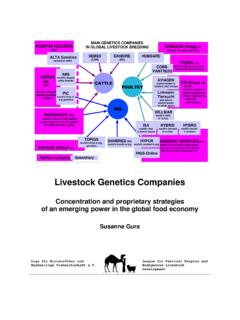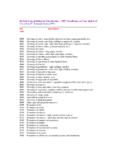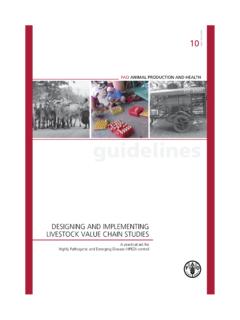Transcription of 1. Background and motivation for the study
1 SHEEP HUSBANDRY AND ETHNOVETERINARY KNOWLEDGE OF RAIKA SHEEP PASTORALISTS IN RAJASTHAN, INDIA. 1. Background and motivation for the study Failure of development efforts Peasants all over the world have developed their own forms of farming to survive. Their way of farming is determined by local possibilities and limitations of ecology and within the social, economic and political structure of their countries and the whole world. Furthermore it is estimated that a large part (three-fourths) of all farming families are scarcely in a position to buy machinery, fertilizers, insecticides, hybrid seeds or veterinary medicines. These low external input farming systems produce a large part of the total agricultural production world-wide and livestock plays an essential role in the agrarian economy of developing countries. More than half of the rural population depends at least in part on livestock for their livelihood, and 12% of the world's population is entirely dependent on livestock production.
2 In the developing countries the role of livestock is often multi-purpose: a source of subsistence (milk, meat, wool, eggs, hides), draught power, manure, additional income (from the selling of animal products), investment, spiritual or religious functions, security and social status. The classification of livestock production systems can be done based on the relative importance of livestock in the system (animal based, mixed crop-animal, crop based), scale of operation (large versus small), utilisation of outputs (subsistence versus commercial), and source of feed (uncultivated lands versus cultivated lands). Broadly, the systems can also be classified into migratory and sedentary systems. (de Jong et al., 1992). Livestock can be seen as a subsystem within a farming system. The lack of appropriate technologies being developed to match the perceptions and resources of farmers can be brought back to this lack of perception where it concerns the role of livestock in a wider perspective than livestock production in itself (Cornelissen, 2001).
3 In contrast with earlier development activities which were initially only involved with the most modern forms of livestock production, including supplies of livestock mainly intended for large-scale dairy farming, these traditional systems need a thorough, interdisciplinary study which consist of a socio-economic and an agro-ecological analysis, as well as analyses of livestock production and official policy. There is no shortage of examples where the actual technology to improve livestock systems in the developing countries were technically inappropriate. This is particularly the case where technologies that work in western countries were transferred to developing countries. A classic example has been the repeated attempts by Dutch government to introduce high yielding Friesian/Holstein cattle into developing countries to increase milk production. Bred for intensive (high input, high output), temperate production systems, these breeds have failed to produce under adverse climatic, disease and management conditions associated with developing countries (Geerlings, 1998).
4 1. SHEEP HUSBANDRY AND ETHNOVETERINARY KNOWLEDGE OF RAIKA SHEEP PASTORALISTS IN RAJASTHAN, INDIA. The multi- and bilateral development institutes (incl. The World Bank) have paid much attention to the development of livestock sectors in developing countries. Set aside some exceptions, mainly in Latin America, Europe and North Africa, the results where disappointing. An internal review of World Bank lending concluded that based on the bank's own criteria of economic return, more than 37% of projects reviewed in 1991 should have been considered unsatisfactory. In the water supply and sanitation sector, 43% of projects were experiencing major problems, in the agriculture sector, 42% (Bond W. 1996). From the analyses of literature it can be concluded that many projects have failed because of the lack of understanding of social, economic, cultural, environmental, and political factors which influence the decision making of the people for whom these development programs are supposed to benefit (Davis 1995, DGIS 1997, Fernandez 1991, Hooft van't 1995, Mathias et al, 1999, Perezgrovas 1992, Vijfhuizen 1992, WWVA 1994).
5 Other important reasons for these disappointing results are; oversimplification of problems; lack of institutional capacity to conduct projects; skepticism about farmer's knowledge and potential contribution, predetermined thinking patterns and gender-blindness, that farming is a predominantly male domain and the lack of interdisciplinary research. Livestock contribution to total food production has been growing at a faster rate than that of the agricultural sector as a whole - a trend that is expected to continue (see table ). The most spectacular increases have been achieved from egg production which has increased by 330% over the last 20 years, with the meat production having increased by 127%, compared with 78% for cereals over the same period. Much of this growth has been derived largely from an increase in animal populations and stimulated, in part, by increasing income and urbanisation. Table : Trends and projections in Food Production in developing countries Million tonnes Growth rate, %.
6 Product 1996/71 1988/90 2010 1970/90 1990/10. Wheat 67 132 205 Rice 177 303 459 Milk Meat 143 Eggs Fish - - - Source: After Agriculture toward 2010". 2. SHEEP HUSBANDRY AND ETHNOVETERINARY KNOWLEDGE OF RAIKA SHEEP PASTORALISTS IN RAJASTHAN, INDIA. Land is becoming scarce, quantitatively as well as qualitatively, due to a more intensive use of land for crop production and subsequent loss of soil fertility, over exploitation of marginal lands and erosion. This problem is most visible in developing countries. Its solution is hampered by: 1. A lack of resources. 2. Weak government policies, at both national and international level. 3. A lack of appropriate technologies and failure of agricultural scientists to develop sustainable technologies that match the perceptions and resources of small farmers. The problem of rising food production is, therefore, complicated because of social, political and economic constraints (Cornelissen, 2001).
7 In the developing countries livestock are an integral part of the local farming system, their contribution to the whole farming system is highly variable and their importance ranges from low in some systems to crucial in others such as in the agro-pastoral system described in this thesis. Several factors play a role in the functioning and production output of such a system. Some of these factors include; available resources and security of their supply, stable markets, environmental conditions (fodder availability) and disease control. The last two mentioned seem to be of highest relevance for the described agro-pastoral system. Animal healthcare interventions Although several governmental and International services exist to prevent, control or eradicate major livestock diseases like rinderpest, anthrax and CBPP, small holders still have to cope with many animal diseases and low fertility and productivity of their animals. Veterinary services -on a regular bases- are out of the question for these small holders who often live to far away from cities or they can not afford to pay for veterinary services.
8 The third world is almost completely dependent on the import of therapeutic drugs and farmer demand for effective drugs has frequently been met by smuggled drugs with all the attendant problems of lack of consistent supply, questionable handling practices, high cost and loss of government tax revenue (Chema et al, ). Furthermore problems associated with the use of modern veterinary drugs are: lack of knowledge of the selection of appropriate drugs, incorrect drug administration, incorrect drug doses, availability of drugs, and ignorance of disposal and withdrawal periods prior to product consumption which may be hazardous to human health. Even with increasing numbers of veterinary graduates, the delivery of veterinary services to the majority of livestock raisers is declining in many developing countries. If primary animal healthcare services are ever to reach a majority of the world's livestock, then as WHO recognised for human patients nearly two decades ago it is necessary to tap all possible practitioner resources, including traditional healers and 3.
9 SHEEP HUSBANDRY AND ETHNOVETERINARY KNOWLEDGE OF RAIKA SHEEP PASTORALISTS IN RAJASTHAN, INDIA. localised paraprofessionals. This imperative is particularly acute wherever livestock are dispersed across large and remote rural areas and/or are nomadic or transhumant, as in the case in many nations of the tropics (McCorkle 1997). Traditionally, veterinarians [and science in general] have tried to discourage traditional medicines in favor of the modern medicine in which they were trained. Scepticism about farmers knowledge and potential contribution stems from an honest appraisal on the part of many dedicated scientists. Researchers simply have not seen hard evidence to prove or disapprove its existence and value. This is partly because farmers seldom record their accomplishments in writing, rarely write papers on their discoveries and do not attach their names and patents to their inventions (Chambers et al, 1990). Modern' medicines are economically often unrealistic to those in the low income groups and those living in remote areas.
10 Ethnoveterinary remedies on the other hand are often freely available, or have a cost in proportion to the value of the animal, or are already part of the culture, often work and are relatively easy to administer (Fielding in Lans, 2001). On the other hand epidemics and fatal endemic diseases are more appropriately treated with commercial drugs and more resources may need to be devoted to these large-scale concerns in the future (Lans, 2001, p 8). In many projects in developing countries, the way in which scientific knowledge is to be combined and interacted with local knowledge of the target-group is an underestimated aspect. Both projects with strong theoretical preferences for either scientific knowledge or indigenous face problems (Hooft van't, 1997). With the foregoing in mind a research was conducted to gather detailed information on the sheep husbandry and healthcare system of the Raikas in Godwar area of Pali district in Rajasthan, India.






